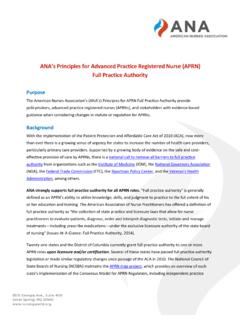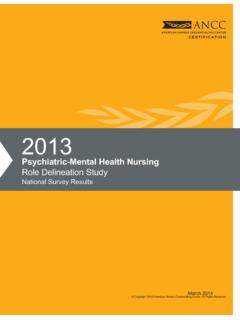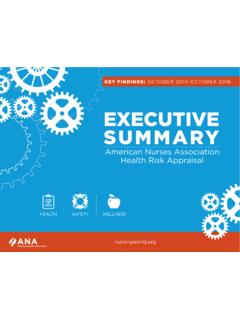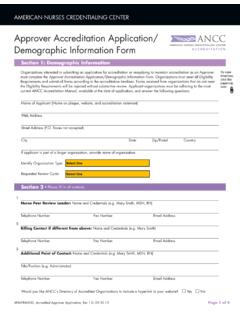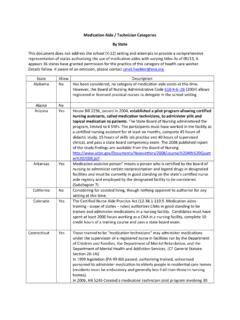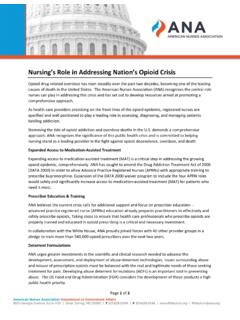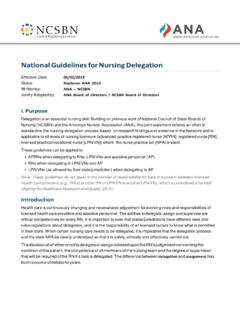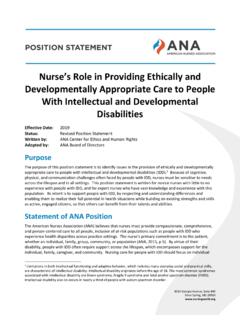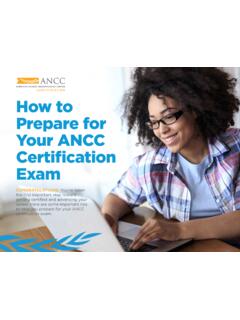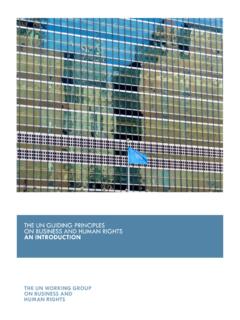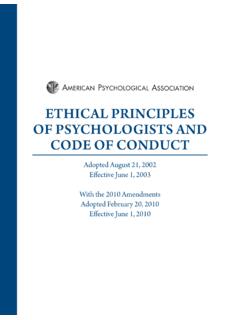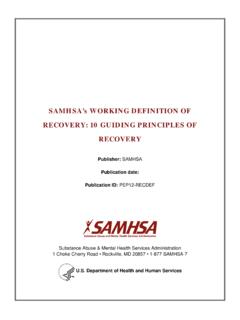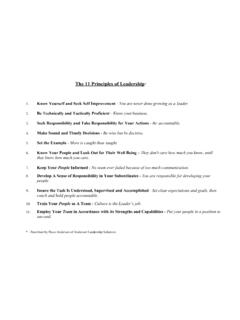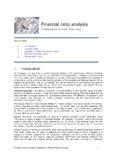Transcription of ANA’s Principles for Nursing Documentation
1 Silver Spring, Maryland2010 ANA sPrinciples for NursingDocumentation Guidance for Registered NursesSummaryClear, accurate, and accessible Documentation is an essentialelement of safe, quality, evidence-based Nursing practice. Nursespractice across settings at position levels from the bedside to theadministrative office; the registered nurse and the advancedpractice registered nurse are responsible and accountable for thenursing Documentation that is used throughout an s Principles for Nursing Documentationidentifies six essentialprinciples to guide nurses in this necessary and integral aspect ofthe work of registered nurses in all roles and settings.
2 American Nurses Association8515 Georgia Avenue, Suite 400 Silver Spring, MD 20910-34921-800-274-4 ANA 2010 American Nurses Association. All rights reserved. No part of this book may be reproduced or utilized in any form or any means, electronic or mechanical, including photocopying and recording, or by any information storage and retrieval system, without permission in writing from the : 978-1-55810-284-2 eBook publication, November 2010 Published by Publishing Program of s Principles for Nursing Documentation 1 Copyright American Nurses AssociationContents2 Overview of Nursing Documentation4 The Uses of Nursing DocumentationCommunication within the Health Care TeamCommunication with Other Professionals 8 Background Publications and Policy Statements11 Nursing Documentation PrinciplesPrinciple 1.
3 Documentation CharacteristicsPrinciple 2. Education and TrainingPrinciple 3. Policies and ProceduresPrinciple 4. Protection SystemsPrinciple 5. Documentation EntriesPrinciple 6. Standardized Terminologies15 Recommendations for Nursing Documentation Practicing Registered NursesEmployers and Health Care AgenciesPatients and Consumers Health Care SystemsNursing EducationNursing Research 20 Glossary 26 References and Bibliography30 Contributors 2010 American Nurses Association. All rights reserved. No part of this book may be reproduced or utilized in any form or any means, electronic or mechanical, including photocopying and recording, or by any information storage and retrieval system, without permission in writing from the of NursingDocumentation ANA s Principles for Nursing Documentation | Overview of Nursing Documentation 2 ANA s Principles for Nursing Documentation | Overview of Nursing Documentation 3 Copyright American Nurses AssociationOverview of Nursing Documentation Clear, accurate.
4 And accessible Documentation is an essential element ofsafe, quality, evidence-based Nursing practice. Nurses practice across settingsat position levels from the bedside to the administrative office; theregistered nurse (RN) and the advanced practice registered nurse (APRN)are responsible and accountable for the Nursing Documentation that is usedthroughout an may include either Documentation onnursing care that is provided by nurses whether RN, APRN, or nursingassistive personnel that can be used by other non-nurse members of thehealth care team or the administrative records that are created by the nurseand used across organization of nurses work is critical as well for effective communicationwith each other and with other disciplines.
5 It is how nurses create a record oftheir services for use by payors, the legal system, government agencies,accrediting bodies, researchers, and other groups and individuals directly orindirectly involved with health care. It also provides a basis for demonstratingand understanding Nursing s contributions both to patient care outcomes andto the viability and effectiveness of the organizations that provide and supportquality patient is sometimes viewed as burdensome and even as adistraction from patient care. High quality Documentation , however, is a necessary and integral aspect of the work of registered nurses in allroles and settings.
6 This requires providing nurses with sufficient time andresources to support Documentation activities. At a time when accessing,generating, and sharing information in health care is rapidly changing, it isparticularly important to articulate and reinforce Principles that are basicto effective Documentation of Nursing is important to bear in mind that this publication s focus on nursingdocumentation is necessarily more that of a conceptual overview than atechnical pace of innovation and adoption of the digitaltechnologies of such Documentation requires this. But the attendant issues ofaccuracy, confidentiality, and security of patient Documentation , in accordancewith regulatory guidelines and mandates, are and will remain paramount,whatever the technological platform.
7 These enduring issues inform andunderline the Principles and recommendations in this publication. 2010 American Nurses Association. All rights reserved. No part of this book may be reproduced or utilized in any form or any means, electronic or mechanical, including photocopying and recording, or by any information storage and retrieval system, without permission in writing from the Uses of NursingDocumentationCommunication within the Health Care TeamCommunication with Other ProfessionalsANA s Principles for Nursing Documentation | The Uses of Nursing Documentation 4 Copyright American Nurses AssociationANA s Principles for Nursing Documentation | The Uses of Nursing Documentation 5 The Uses of Nursing Documentation Nurses document their work and outcomes for a number of reasons.
8 Themost important is for communicating within the health care team andproviding information for other professionals, primarily for individualsand groups involved with accreditation, credentialing, legal, regulatoryand legislative, reimbursement, research, and quality within the Health Care TeamNurses and other health care providers aim to share information aboutpatients and organizational functions that is accurate, timely,contemporaneous, concise, thorough, organized, and is communicated verbally and in written and electronicformats across all settings. Written and electronic Documentation areformats that provide durable and retrievable of such electronic Documentation is the electronic health record(EHR), provides an integrated, real-time method of informing the healthcare team about the patient Documentation of thefollowing types of information should be made and maintained in apatient s EHR to support the ability of the health care team to ensureinformed decisions and high quality care in the continuity of patient care.
9 Assessments Clinical problems Communications with other health care professionals regarding the patient Communication with and education of the patient, family, and the patient s designated support person and other third parties Medication records (MAR) Order acknowledgement, implementation, and management Patient clinical parameters Patient responses and outcomes, including changes in the patient s status Plans of care that reflect the social and cultural framework of the patient 2010 American Nurses Association. All rights reserved. No part of this book may be reproduced or utilized in any form or any means, electronic or mechanical, including photocopying and recording, or by any information storage and retrieval system, without permission in writing from the American Nurses AssociationCommunication with Other Professionals Patient Documentation frequently is used by professionals who are not directly involved with the patient s care.
10 If patient Documentation is not timely, accurate, accessible, complete, legible, readable, andstandardized, it will interfere with the ability of those who were notinvolved in and are not familiar with the patient s care to use thedocumentation. Some of the most common areas of interprofessionaluse of Nursing Documentation that are outside the direct care team aresummarized Nursing Documentation , such as patient care documents, assessments ofprocesses, and outcome measures across organizational settings, serve tomonitor performance of health care practitioners and the health carefacility s compliance with standards governing the profession andprovision of health care.
